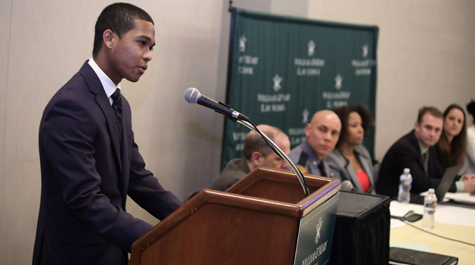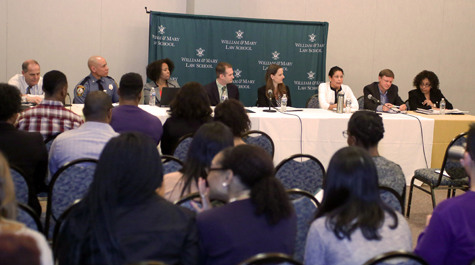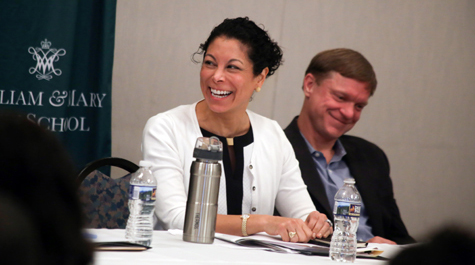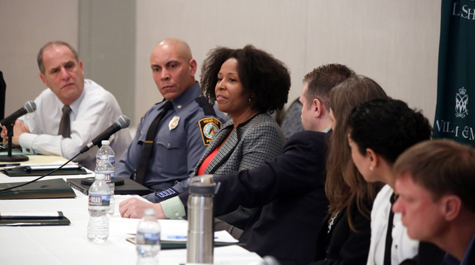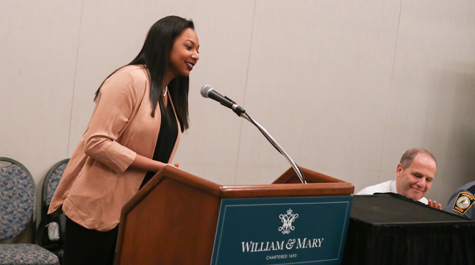Experts at BLSA’s Annual Symposium Examine Implicit Racial Bias
The formula for the Black Law Students Association’s annual symposium at William & Mary is simple, but powerful.
Take an important current topic concerning race and the law, add a strong mix of established experts in various fields, and let the conversation begin to flow.
This year’s symposium, held on Thursday, February 23, saw legal academics, psychologists, educators, and a law enforcement officer gather in William & Mary’s Sadler Center to explore “The Influence of Implicit Racial Bias in Society and Criminal Justice.”
“We’ve had a deep understanding for a long time in this country of explicit racism, and in more recent years we’ve developed an understanding of structural racism,” said Dean Davison M. Douglas in his opening remarks. “The insight of the last 15 years or so has been about implicit racism, or implicit racial bias…and we have a terrific, diverse group of people to address different aspects of this topic.”
Led by moderator Paul Marcus, Haynes Professor of Law at William & Mary, the first half of the event gave each panel member time to discuss issues of implicit bias from their own academic and professional backgrounds.
Looking at the problem from a legal perspective were Vivian Hamilton, Professor of Law at William & Mary; Gregory Mitchell, the Joseph Weintraub-Bank of America Distinguished Professor of Law and the Thomas F. Bergin Teaching Professor of Law at the University of Virginia; and Gloria Whittico, associate professor and director of academic success at Regent University School of Law.
Hamilton began by providing an overview of implicit race bias, defining it as “mental shortcuts that allow us to assign objects, people, processes into categories…and once we assign an object or person into a certain category, the meanings we associate with that category also become associated with that object.”
Hamilton also explored the difference between implicit and explicit bias, and discussed such tools as the Implicit Association Test, which can be useful in alerting people to stereotypes and prejudices they may unconsciously possess.
Tracy Sohoni, a visiting sociologist at William & Mary, was also on hand to look at how biases arise not from individual inclination, but from societal context.
Adding psychological viewpoints were Natoya Hill Haskins from the Department of School Psychology and Counselor Education at William & Mary, and Walter Gilliam, Director of The Edward Zigler Center in Child Development and Social Policy, and Associate Professor of Child Psychiatry and Psychology at the Yale University Child Study Center.
Rounding out the panel, Assistant Chief of Police Clarence Hunter, Jr., Henrico County Police Division brought years of experience in law enforcement to the discussion.
The second hour saw panelists field questions from students in the audience. Not surprisingly, conversations went into depth about solutions to implicit bias and how to address implicit bias at a micro level (for example, individual conversations) outside of structured organizational settings. A wealth of other topics were also explored.
In her closing remarks, BLSA President Mary Pickard J.D. ’17 thanked the panel for bringing awareness of implicit bias to campus.
“I hope this isn’t the last of the conversations we continue on William & Mary’s campus, not only at the Law School, but also with the undergrad and other graduate programs at the College,” Pickard said.
The symposium was supported by the William & Mary School of Education, American Constitution Society at William & Mary Law, and the Jewish Law Students Association at William & Mary Law. The printed program was made possible by a generous grant from the Diversity Endowment through the Office of Diversity & Inclusion.
About William & Mary Law School
Thomas Jefferson founded William & Mary Law School in 1779 to train leaders for the new nation. Now in its third century, America's oldest law school continues its historic mission of educating citizen lawyers who are prepared both to lead and to serve.
